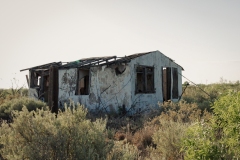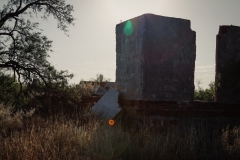One town, two booms.
Pyote was a small town for quite a while. It began with the newly built Texas and Pacific Railway in 1881. A post office and store opened in 1907 to serve the very small community.
Boom one: Oil
New reports from 1919 showed thousands of acres of land were being purchased for oil exploration. In an article from the Abilene Semi Weekly Farm Reporter, local cowboys referred to wells with strong gas flow, or “blowing wells” and predicted an immense development program. They seemed to get it right, although not immediately. The official discovery of oil happened in 1926 and a town of 100 residents suddenly became 3,500.
Houses, stores, hotels, schools, a newspaper and everything such a populous demanded were made available seemingly overnight. Numerous big companies were buying land to open businesses. In 1927, the Abilene Morning Reporter called Pyote, “One of the fastest growing oil towns in the west.” It became an oil trading and shipping center for the area in 1928.
Unfortunately, the excitement only lasted 5 years. The railroad built a spur to Monahans and Pyote would no longer be able to easy ship its oil. The business didn’t completely dry up, it just slowed down and so did jobs. Families leaving to find new opportunities did not leave much of a reason for businesses from bigger cities to stay, so they closed and left buildings vacant. Two-thirds of the town moved during this time. The Pyote Gazette ceased publication in 1930’s.
By 1941, residents dwindled to 200 in a town built for 3,500 or more.
Boom two: Wartime Military
Pyote Army Airfield was built in late 1942 as a training facility for B-17 Flying Fortress and B-29 Super Fortress. It soon became the largest bomber installation in the U.S. The land was very popular for rattlesnakes and signs had to be posted warning to wear boots and gloves and to watch ones step and reach. This lead to the nickname Rattlesnake Bomber Base, which history has shown to be the more memorable name.
The base became an aircraft storage depot after the war. One of the most notable to spend some time there was the “Enola Grey,” which dropped the atom bomb over Hiroshima, Japan. Events were held where civilians could come see the huge silver bomber before shipping off to the Smithsonian.
The airfield went to standby status in 1953, essentially keeping a small crew of caretakers but leaving everything as-is for possible use if needed. It was reopened briefly in 1958 as Pyote Air Force Station and a portion of the grounds were used as a radar installation. Another part would be dedicated to scrapping old aircraft. Eventually, up to 4,000 were broken down, melted, and buried.
When it was completely deactivated, the land was returned to the University of Texas Lands in 1966. Part of the base with living quarters was taken over by the West Texas Children’s Home of Pyote, which was an orphanage. It was converted to the West Texas State School, which was a juvenile detention center in 1980. After The Texas Observer reported on sexual abuse, and difficulties staffing up to 300 people in such a remote location, it closed in 2010. In 1976, hangers were auctioned for salvage. The military officially had no more use for Pyote.
All that remains today is the empty detention center, one large partial structure, some foundations, and miles of cracked runways covered in tall grass and more rattlesnakes than you can shake a stick at. When Interstate 20 was built, it went right through the original base entrance. The front now sits on one side and goes about 30-feet before abruptly ending at the shoulder. Everything else is on the other side.
A community still holds on to Pyote, despite how their town was rapidly expanded and the abandoned. One or two homes per block are used and many haven’t been lived in for years. Most of the business area is either gone or abandoned. Children attend school 20 miles away in Monahans. Still, approximately 100 people this town home. I met a gentleman who converted the old 2-story teacherage into a house. This building looks like an old schoolhouse but actually served as a residence for teachers in an effort to recruit them into a fast-growing area. The outside gives the appearance of an abandoned building with broken windows. However, he has connected electricity and made the inside work for him. For those who have something here, it’s not too far from towns with shopping, and someone could live in a very quiet town.















